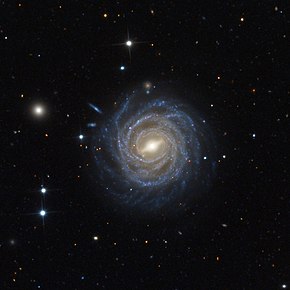| NGC 521 | |
|---|---|
 NGC 521 as seen on an image recorded the Mount Lemmon Observatory using the 32-inch Schulman reflecting telescope in 2015 | |
| Observation data (J2000[1] epoch) | |
| Constellation | Cetus[2] |
| Right ascension | 01h 24m 33.8s[3] |
| Declination | +01° 24′ 33.8″[3] |
| Redshift | 0.016902[1] |
| Heliocentric radial velocity | 5024.3 km/s[1] |
| Distance | 224 Mly[4] |
| Apparent magnitude (V) | 11.7[2] |
| Apparent magnitude (B) | 12.5[2] |
| Characteristics | |
| Type | SBbc[2] |
| Apparent size (V) | 2.7' × 2.4'[2] |
| Other designations | |
| PGC 5190, UGC 962, GC 304, MGC +00-04-118, 2MASS J01243377+0143532, h 115, IRAS 01219+0128[1][5] | |
Preview warning: Page using Template:Infobox galaxy with unknown parameter "upright"

NGC 521, also occasionally referred to as PGC 5190 or UGC 962, is a barred spiral galaxy located approximately 224 million light-years from the Solar System[4] in the constellation Cetus.[2] It was discovered on 8 October 1785 by astronomer William Herschel.[5]
- ^ a b c d "NGC 521". SIMBAD. Centre de données astronomiques de Strasbourg. Retrieved 2017-12-09.
- ^ a b c d e f "Revised NGC Data for NGC 521". spider.seds.org. Retrieved 2017-10-05.
- ^ a b "Your NED Search Results". ned.ipac.caltech.edu. Retrieved 2017-10-05.
- ^ a b An object's distance from Earth can be determined using Hubble's law: v=Ho is Hubble's constant (70±5 (km/s)/Mpc). The relative uncertainty Δd/d divided by the distance is equal to the sum of the relative uncertainties of the velocity and v=Ho
- ^ a b "New General Catalog Objects: NGC 500 - 549". cseligman.com. Retrieved 2017-10-16.